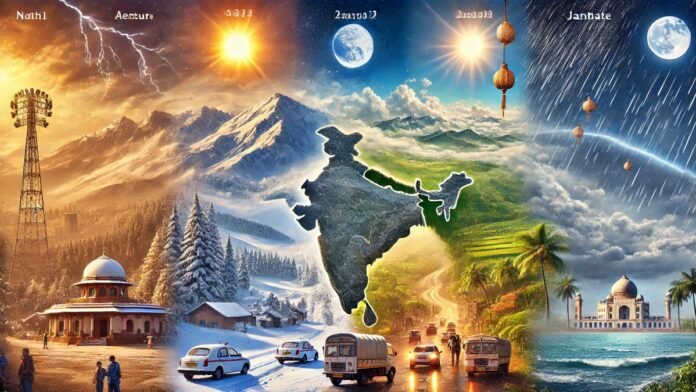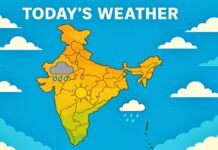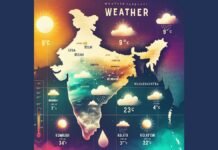
Key Points
- IMD issues heavy rain warnings for Bihar, Jharkhand, and parts of Uttarakhand with thunderstorms expected
- Delhi and UP to experience clear skies with temperatures ranging 24-36°C through September 15
- Excessive rainfall recorded in northeastern states, parts of South India, and Maharashtra in past 24 hours
- Flood risks reduced in UP as river water levels decline, all districts in green zone
- Extended forecast shows continued rainfall in Northeast and South India through September 20
- Travel advisories issued for affected regions due to waterlogging and potential landslides
New Delhi: The India Meteorological Department (IMD) has issued a mixed weather forecast for September 15, 2025, with contrasting conditions across different regions. While northern plains including Delhi and Uttar Pradesh are expected to enjoy clear skies, several states face the threat of heavy to very heavy rainfall accompanied by thunderstorms and lightning.
In the past 24 hours, meteorological stations have recorded significant precipitation across multiple regions. The most intense rainfall has been observed in Bihar’s flood-prone areas, Sub-Himalayan West Bengal, Sikkim, and various districts of Himachal Pradesh, with some areas receiving over 115mm of rainfall.
Regional Weather Forecasts
Delhi NCR
The national capital region will experience predominantly clear weather conditions on September 15. Morning hours may see partially cloudy skies, but overall visibility and conditions remain favorable for outdoor activities. Temperature readings show maximum values between 34-36°C and minimum temperatures settling at 24-26°C.
Wind patterns indicate northwestern flows at 20-22 kmph during morning hours, gradually decreasing to below 12 kmph by evening. Humidity levels are expected to remain moderate, providing relatively comfortable conditions for residents.
Uttar Pradesh
All 75 districts of Uttar Pradesh have been placed in the green category by the IMD, indicating no immediate weather-related threats. This marks a significant improvement from recent flood concerns, as major river systems including the Ganga, Yamuna, and Rapti have shown declining water levels.
The state’s agricultural regions can expect ideal conditions for ongoing kharif crop activities. Temperature patterns mirror those of Delhi, with maximum readings of 34-36°C and minimum temperatures at 24-26°C across most districts.
Bihar
Critical weather conditions persist in Bihar with heavy rainfall warnings issued for eight districts. The most vulnerable areas include Saran, Muzaffarpur, Vaishali, Samastipur, Khagaria, Araria, Kishanganj, and Supaul, where rainfall intensity may exceed 64.5mm in 24 hours.
Local disaster management authorities have activated emergency protocols, establishing relief camps and deploying rescue teams in anticipation of potential flooding. Residents in low-lying areas have been advised to relocate to higher ground and avoid venturing into waterlogged zones.
Jharkhand
Ten districts across Jharkhand face heavy rainfall threats, particularly in the mineral-rich regions of Giridih, Bokaro, and the tribal belt covering Dumka, Godda, and Sahebganj. The state’s mining operations have been placed on high alert due to potential disruptions from waterlogging.
Transportation networks, including National Highway 2 and major state highways connecting Ranchi to eastern districts, may experience significant disruptions. The state transport corporation has issued advisories for modified bus schedules and route diversions.
Uttarakhand and Himachal Pradesh
Uttarakhand’s hill districts present a contrasting scenario, with five districts under heavy rain watch. Bageshwar, Champawat, Nainital, Chamoli, and Pithoragarh face particular risks due to their mountainous terrain and vulnerability to landslides.
The Uttarakhand State Disaster Response Force (SDRF) has positioned teams at strategic locations along major pilgrimage routes including the Char Dham circuit. Temporary suspension of helicopter services to high-altitude temples may be implemented if conditions deteriorate.
In contrast, Himachal Pradesh enjoys stable weather conditions with all districts maintaining green zone status. The state’s apple harvesting season continues uninterrupted, providing relief to agricultural communities.
Extended Forecast and Regional Patterns
Northeast India
The northeastern states will continue experiencing active monsoon conditions through September 20. Arunachal Pradesh faces the prospect of light to moderate rainfall with isolated heavy spells until September 17. The remaining six sister states—Assam, Meghalaya, Nagaland, Manipur, Mizoram, and Tripura—should prepare for widespread rainfall and thunderstorm activity during September 15-16 and September 18-20.
South India
Tamil Nadu’s coastal and interior districts are positioned to receive light to moderate rainfall between September 16-19, accompanied by strong surface winds reaching 30-40 kmph. This weather pattern may provide relief from recent heat conditions but could impact ongoing agricultural operations.
Central India
Rainfall activity in central regions shows a declining trend, with West Madhya Pradesh and Vidarbha expecting precipitation only until September 16. East Madhya Pradesh and Chhattisgarh face isolated rainfall events on September 15, after which conditions are expected to stabilize.
The Andaman and Nicobar Islands will experience renewed rainfall activity from September 17-19, potentially affecting inter-island transportation and tourism activities.
Impact Assessment and Safety Measures
Agricultural communities across affected regions have been advised to postpone harvesting activities and secure stored crops. Urban areas prone to waterlogging, particularly in Bihar and Jharkhand, have activated drainage systems and deployed pumping equipment at critical locations.
The National Disaster Response Force (NDRF) has pre-positioned teams in vulnerable districts, while state governments have established 24/7 control rooms for emergency coordination. Citizens are urged to stay informed through official weather updates and avoid unnecessary travel in high-risk areas.













































